We should have known we were in for something out of the ordinary. On our first trip to Skyros, newly arrived, Saturday evening, all our enquiries about the return boat to Kymi on Monday (Kathari Deftera/CIean Monday) were met with evasive smiles, and a vague “Well maybe, but then again maybe not!” In the event, the ticket office remained stubbornly closed until Monday evening, and the rickety Anemoessa (now in semi-retirement on a trunk line in the Dodecanese and replaced by the possibly more punctual Lykomedes) didn’t run. This, it turned out, was not entirely due to snow…
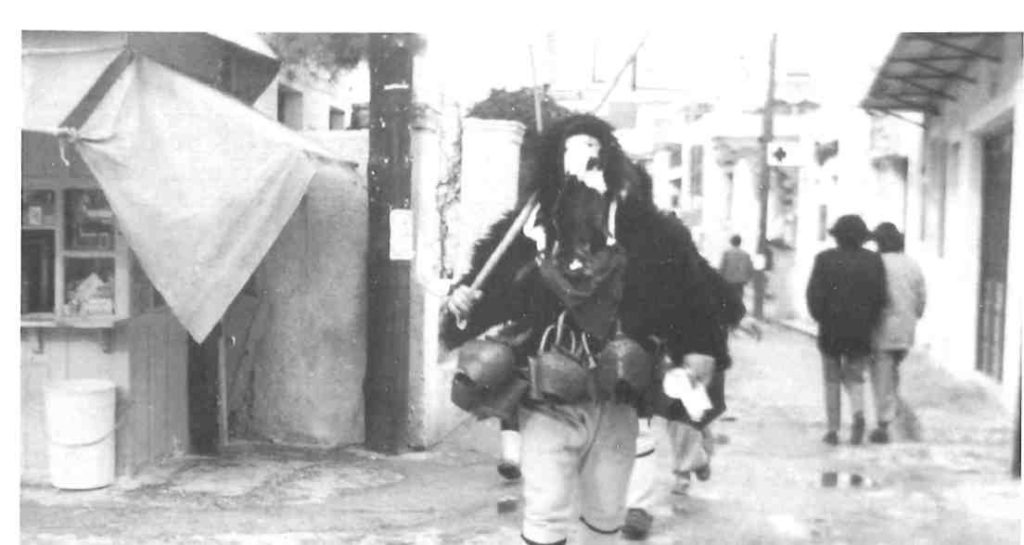
Up in the town, meanwhile, the eerie clanking of goat bells that has accompanied the celebrations of Apokries from time immemorial, had already begun, and our vain search for a room with heating brought us face to face with our first yeros, looming like a demi-devil out of the bleak February evening.
For much longer than anyone can remember, throughout Apokries, but especially on Tyrinis, or Cheese Sunday – so-called as it is the last day on which cheese may be eaten before Lent begins on Kathari (Clean) Monday – the young men of Skyros have dressed up, or disguised themselves (the Greek metamphiezo carries both meanings) as yen, literally ‘old men’. The most striking feature of their dress, which transforms them from man into half-beast, is the mask: the skin of a still-born kid, pulled up over the face with two eyeholes cut, the head dangling like a sort of trunk on the wearer’s chest. Around the head and torso is worn the traditional black Macedonian woollen shepherd’s jacket, inside (hairy-side) out, with a pillow or rags stuffed up the back to give an appearance of a hump. The hood is secured with a long white shepherd’s belt, knotted at the back and crossed over at the shoulders, the two ends joined at the front with a colorful handkerchief. By means of ropes, as many as 70 or 80 copperplated goat bells (depending on the stamina of the wearer) are attached around the yeros’ waist, suspended from the wooden collar, with the larger bells at the back and the smaller ones at the front. On his legs, the yeros wears traditional white woollen trousers, white leggings, and trohadia, thonged Skyrian shepherd’s sandals, very reminiscent of ancient Greek sandals except that, nowadays, the sole is often, more practically perhaps, made from an old car tire rather than leather. No yeros’ costume is complete without the shepherd’s crook, which he uses to steady himself or to juggle in the air and poke at onlookers.
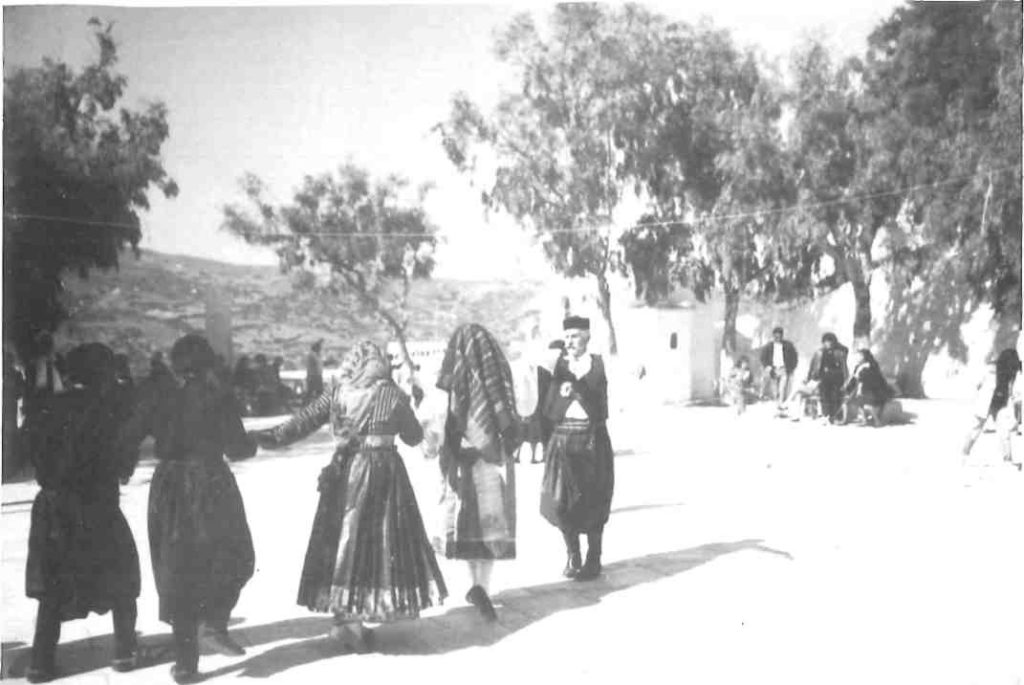
In the past, the yeri would appear regularly throughout Apokries, but nowadays their appearance is largely restricted to the last two Sundays, perhaps because many of the young men have moved away from the island and return especially to become yeri. They trip lightly in and out the narrow alleyways and tunnelled passages of the town and all they way up to the rock above the town and the monastery of St George with remarkably springy steps, considering the terrific weight of all those bells! Sometimes they move in groups, sometimes alone, now and then gathering in a circle for what appears to be a show of strength. With legs apart and crooks firmly planted in front to steady themselves, they bend back and forth from the waist, shaking their shoulders at the same time – the noise is incredible.
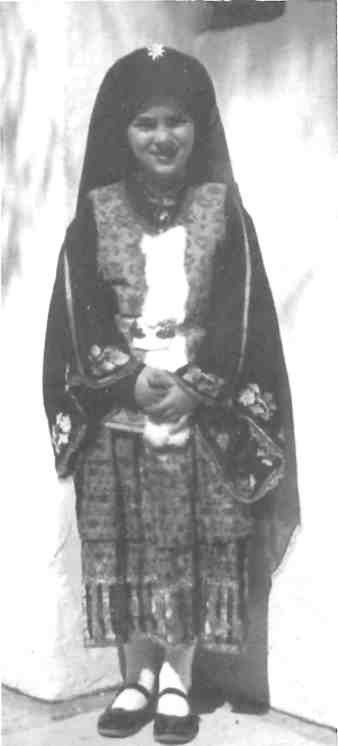
The yeros’ traditional companion is the korella: a man (or, more often these days, a woman – women even dress up as yeri now) in Skyrian bridal dress, with a few accessories such as an apron, woollen leggings, trohadia and a paper mask. Waving a handkerchief, (s)he skips merrily around her chosen yeros. The couple attracts a whole host of other masqueraders wearing more makeshift costumes on their way through the town, some carrying fishing nets or mops and taking the odd swipe at bystanders, others in more modern somewhat incongruent plastic masks. As all over Greece, the children dress up, too, some as the inevitable Spanish ladies and ninjas, but others in all the regalia of a miniature yeros.
On the afternoon of Tyrinis, a large crowd assembles, and a sat ha or komodia is performed in the main square of the town – perhaps portraying a mock wedding or a shipwreck’. One of the cast usually recites a satirical poem – a chronicle of the past year’s politics and its effect on the island.
Partying continues well into the small hours of Kathari Deftera. Family groups congregate in tavernas and kafeneia, singing, dancing, and consuming vast quantities of local retsina. Some hardy ones carry on all night, moving on to their homes when the tavernas close for yet more wine and some home-made trahanopitta – a traditional Lenten pie with a filling of crushed wheat boiled in milk.
The next day, Kathari Deftera, there is a tangible change in the atmosphere. The bawdiness and drunkenness of the night before give way to sobriety and order. Men, women and children alike (even bashful teenagers) put on the local dark blue shepherd’s ‘Sunday best’. Some women wear the koumiotika – the traditional women’s dress for Kymi. All the yeri and korelles of the night before are gone. At midday, folk dances are performed in the square, more orderly and calm than the revels of the previous day, as befits an important Christian festival.
To an outsider, the obvious question is ‘why’? Why, when much of the rest of Greece is peacefully watching the Patras carnival on TV and tucking in to their halva, do the people of Skyros celebrate with such fervor? But like many of man’s most exuberant festivals, the ‘why and wherefore1 have been transcended by the event itself as a separate entity. Ask a Skyrian ‘why’ and he will not be able to tell you, except, perhaps, in an attempt at rationalization, or (quoting what he has read in Joy Coulentianou’s definitive book The Goat Dance of Skyros) to tell the story: one very, very cold winter many, many years ago when thick snow lay on the ground for many weeks – when, after the thaw, the goatherds went out to count their losses, they found every single goat dead from the cold, and returned to the town with the bells tied around their waists so that their womenfolk might understand…
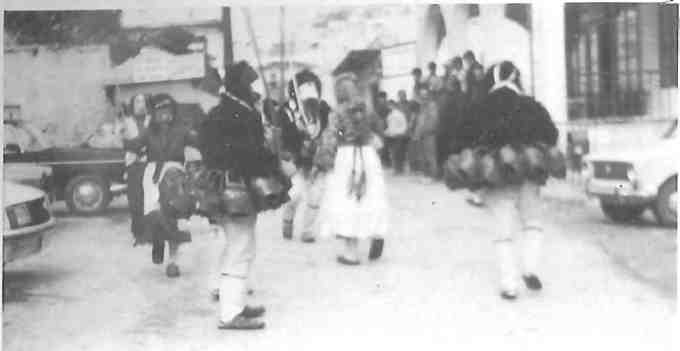
There can be little doubt, (there are too many coincidences) about the partly Dionysiac roots of the festival, although its true origins may go back even further than that. Dionysos tended to be identified with different horned animals (bulls, stags or goats) depending on the place and Skyros is one of the most central islands in a sea whose name is etymologically linked to the ancient Greek word for goat, aegos or aex. The eponymous King Aegeus, whose name means ‘goatish’, threw himself to a rocky death from Cape Sounion, and Theseus, his son, himself met a similar fate in Skyros at the hands of Lykomedes. In ancient times, the milk productivity of Skyrian goats was proverbial. The expression aex Skyria was a synonym for productive.
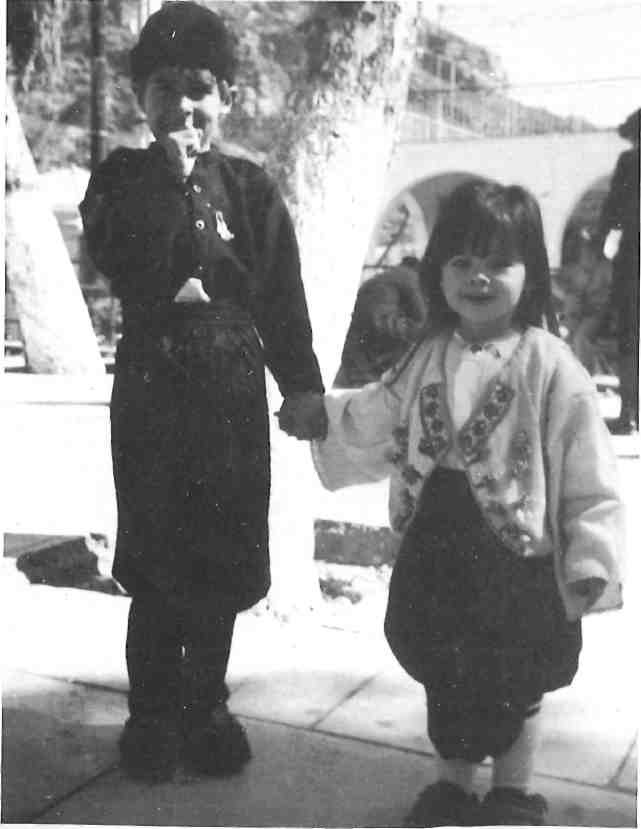
shepherd’s ‘Sunday best’.
There was an early cult of Dionysos the kid, while the goat was the animal most commonly sacrificed to him. The god is frequently depicted in art with goatmen as companions, and according to myth, he was disguised in infancy as a kid or ram to escape from the wrath of Hera during which time he was nurtured by nymphs. He also, of course, invented wine (drunk so copiously in Skyros during Carnival). Another telling coincidence is that Dionysos is usually portrayed as a long-haired, effeminate youth, and was said to have been reared as a girl. In a similar story Achillles was sent by his mother, Thetis, to the court of Lykomedes in Skyros in the disguise of a girl to prevent him from going to the Trojan war. Men dressed as women, as we have seen, are an important feature of the Skyrian carnival.
We know that there were two big celebrations in honor of Dionysos in Attica – the Greater (or ‘City’) and Lesser (or ‘Rural’) Dionysia. Both were essentially fertility festivals intended to help stimulate agricultural growth in the coming spring. The fact that they took place in the winter, when there was less agricultural activity, meant that people had more free time to enjoy the festivities. As civilization grew more sophisticated, Dionysos was thought to rule at feasts of merry-making, banishing all sadness and everyday cares. For his followers, life became a series of noisy, disordered celebrations.
With the advent of Christianity, the ancient Dionysian festivals merged with the new pre-Lenten celebrations (the earliest recorded Apokries celebrations are from the 13th century) . The church made several attempts to ban the ‘pagan’ custom of fancy dress, but was eventually forced to incorporate this, and other less tasteful aspects of pre-Christian religion. Away from the mainland compulsion to change and conform, perhaps it is not surprising that on an island like Skyros, where whole species of animals (like the miniature Skyrian ponies) have avoided the mainstream of evolution, some special customs have been preserved.







